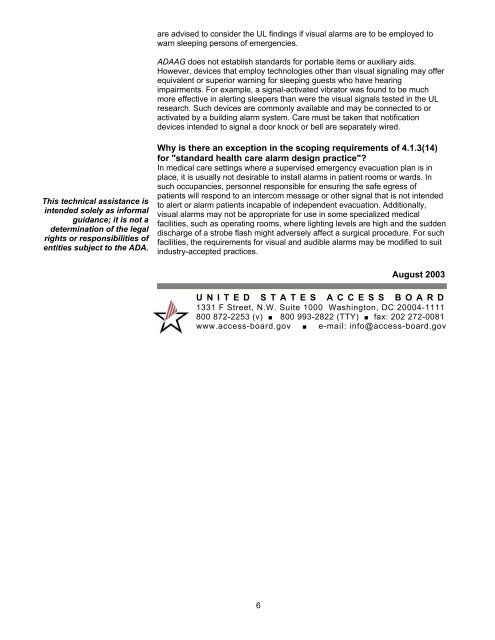Fire Protection Design Manual - Office of Construction and Facilities ...
Fire Protection Design Manual - Office of Construction and Facilities ...
Fire Protection Design Manual - Office of Construction and Facilities ...
You also want an ePaper? Increase the reach of your titles
YUMPU automatically turns print PDFs into web optimized ePapers that Google loves.
This technical assistance is<br />
intended solely as informal<br />
guidance; it is not a<br />
determination <strong>of</strong> the legal<br />
rights or responsibilities <strong>of</strong><br />
entities subject to the ADA.<br />
are advised to consider the UL findings if visual alarms are to be employed to<br />
warn sleeping persons <strong>of</strong> emergencies.<br />
ADAAG does not establish st<strong>and</strong>ards for portable items or auxiliary aids.<br />
However, devices that employ technologies other than visual signaling may <strong>of</strong>fer<br />
equivalent or superior warning for sleeping guests who have hearing<br />
impairments. For example, a signal-activated vibrator was found to be much<br />
more effective in alerting sleepers than were the visual signals tested in the UL<br />
research. Such devices are commonly available <strong>and</strong> may be connected to or<br />
activated by a building alarm system. Care must be taken that notification<br />
devices intended to signal a door knock or bell are separately wired.<br />
Why is there an exception in the scoping requirements <strong>of</strong> 4.1.3(14)<br />
for "st<strong>and</strong>ard health care alarm design practice"?<br />
In medical care settings where a supervised emergency evacuation plan is in<br />
place, it is usually not desirable to install alarms in patient rooms or wards. In<br />
such occupancies, personnel responsible for ensuring the safe egress <strong>of</strong><br />
patients will respond to an intercom message or other signal that is not intended<br />
to alert or alarm patients incapable <strong>of</strong> independent evacuation. Additionally,<br />
visual alarms may not be appropriate for use in some specialized medical<br />
facilities, such as operating rooms, where lighting levels are high <strong>and</strong> the sudden<br />
discharge <strong>of</strong> a strobe flash might adversely affect a surgical procedure. For such<br />
facilities, the requirements for visual <strong>and</strong> audible alarms may be modified to suit<br />
industry-accepted practices.<br />
August 2003<br />
U N I T E D S T A T E S A C C E S S B O A R D<br />
1331 F Street, N.W. Suite 1000 Washington, DC 20004-1111<br />
800 872-2253 (v) ■ 800 993-2822 (TTY) ■ fax: 202 272-0081<br />
www.access-board.gov ■ e-mail: info@access-board.gov<br />
6

















